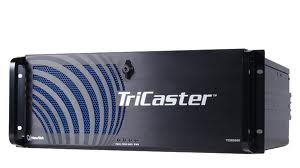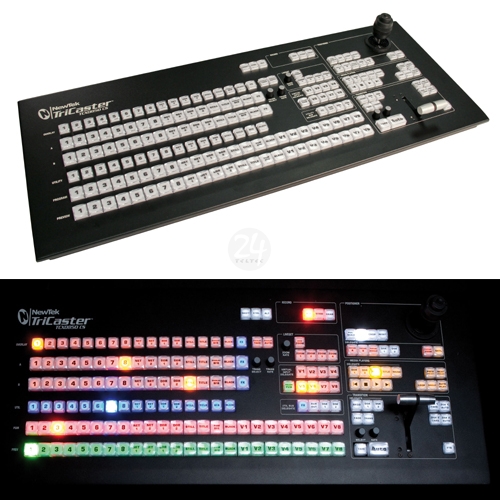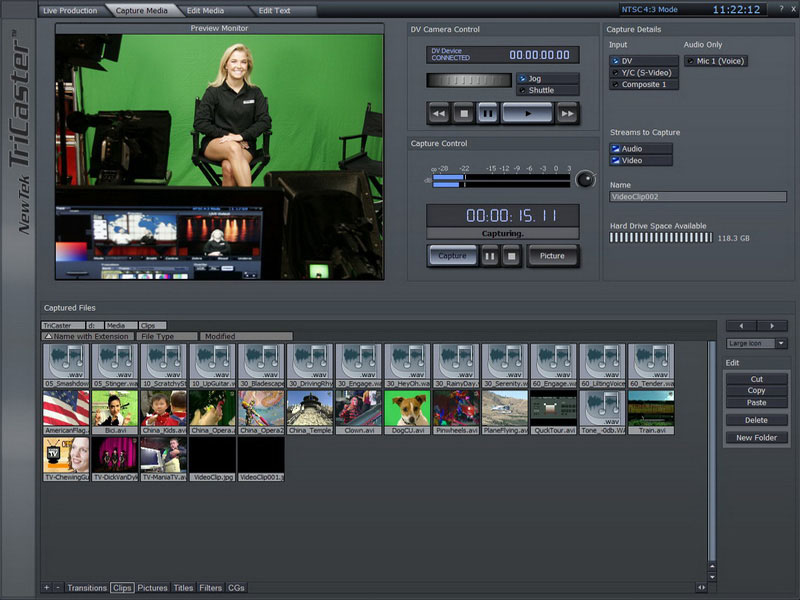Review: NewTek TriCaster 850 Extreme
The Extreme version provides a number of enhancements over the original TCXD850 including full HD recording treatment, with the ability to record 1080p30 of any discrete input as well as the program or AUX outputs (the TCXD850 could record only outputs). This extended ability to record both inputs and outputs means that 850 Extreme can perform isolation recording of up to 8 simultaneous camera inputs with its proprietary IsoCorder software.
Page 1
Newtek's long history in video production switchers-starting with the Amiga-based Video Toaster and more recent portable TriCaster units-takes an extreme leap forward with the rackmountable TriCaster 850 Extreme.
Looking more like a four-rack-unit (4 RU) computer server than a traditional TriCaster, this is a TriCaster geared toward studio or broadcast facility integration rather than field production.
What Makes it Extreme?
With 8 simultaneous video inputs and 3 simultaneous video outputs, the TriCaster 850 Extreme is itself a souped-up version of the TriCaster TCXD850, which Newtek launched in 2010. Like the TCXD850, the 850 Extreme has 4:4:4:4 video processing and uses a 32-bit Floating Point processor functionality.
The eight simultaneous video inputs can use any combination of, HD-SDI, HD Component, SD-SDI, SD Component, Y/C (BNC), or Composite. For those who want the SMPTE specs, that would be SMPTE 292M (HD-SDI) and SMPTE 259M/ITU-R BT.656 (SD-SDI).
The Extreme version provides a number of enhancements over the original TCXD850 including full HD recording treatment, with the ability to record 1080p30 of any discrete input as well as the program or AUX outputs (the TCXD850 could record only outputs). This extended ability to record both inputs and outputs means that 850 Extreme can perform isolation recording of up to 8 simultaneous camera inputs with its proprietary IsoCorder software.
The ability to record each input simultaneously and in isolation is helpful for a number of use case scenarios, including: surveillance, multi-camera shoots where later editing might be required, and sporting events where one camera tracks a particular player.

Key Components
Let's look at a few key physical features of the TCXD850 Extreme:
Physical device
The pieces comprising the TriCaster TCXD850X are a computer and up to two human-user interface (HUI) devices.
HUI devices
The TC 850 CS (control surface) is the main human-user interface for the 850 Extreme, although almost every click and selection can be mimicked with a mouse on the screen. Given the option, it appears most users would want to use the TCXD850 CS, as its buttons are straightforward and provide visual feedback by changing colors when pressed. Yet as many buttons as the TC 850 CS has at first glance, it's actually capable of up to 3x the button options, thanks to the ALT and FTN (function) buttons at the top row of the HUI device. In our testing, the use of the TC 850 CS buttons (including the ALT and FTN buttons) was much faster than using the mouse-and-keyboard combination (required to get the ALT/Fn combinations in a mouse-driven scenario).

For those who are overwhelmed by the "bigness" of the TC 850 CS, the venerable LC-11 control surface that we've all come to know and love can also be used to control the 850 Extreme. One other HUI can be used: the TriCaster 850 TW. A "time warper" of sorts, TC 850 TW provides tactile control for slow motion and instant replay when connected to a TriCaster system that supports Media Players (DDRs).
Computer
At 7.25" high (4 RU) and 19.5" wide, 850 Extreme fits into a standard rack configuration. A depth of 21.5 means the 850 Extreme is a very tight squeeze in a typical AV rack but will be fine in a deeper data-equipment rack. The size and bulk is one of the first indications that the 850 Extreme is designed to be permanently mounted, unlike earlier TriCasters whose square (and shallower) form factor worked for desktop- and field-based use cases. The upside of all this extra space is the combination of Sandybridge architecture and a decent amount of processing firepower: the 850 Extreme has two Intel i7 quad-core 3.4 Ghz processors, for a total of 8 cores, and NewTek takes advantage of the multi-core/multi-threading capabilities in several of its features.

As a computer-based system, the 850 Extreme relies on Windows 7 Professional 64-bit for its operating system-the question of points of failure typical to a computer-based video mixer immediately come to mind. Several of these issues include power supply redundancy, network redundancy, and video loop-through capabilities.
Network redundancy is one area lacking on both the TCXD850 and 850 Extreme units: each version has only a single 1GB Ethernet connector, meaning that fail-over and load-balancing between network switches isn't a possibility on these TriCasters. A single Ethernet connector makes sense for field-deployed TriCasters, but makes little sense on a rack-mounted unit that claims streaming as one of its key features.
Power supply redundancy is robust on the TriCaster 850 Extreme, as the unit contains two hot-swappable power supplies, each with an audible warning beep that continues until the unit is replaced. It might make sense to offer a way to shut off the beep, as its decibel level and insistence on being dealt with could be distracting in the middle of a production in closed quarters, but then again the warning system does its job well.
Inputs and Outputs
The back of the 850 Extreme has an almost overwhelming number of inputs and outputs. Ranging from AES audio to multiple analog and digital video options, the TCXD850X has an input option for almost every use-case scenario.
Video
Video input and output options are all based on BNC connectors, and each input has at least three BNC connectors to allow the choice of component, composite, Y/C or SDI inputs. Given the number of BNC connectors for the 8 inputs and 3 outputs (video 1/2 and AUX outs) the back of the 850 Extreme more resembles a video matrix switch from Extron or other A/V gear manufacturers than it does the traditional video mixer setup; an included BNC insertion tool is a welcome and thoughtful addition for those of us with oversized fingers or a fear of small places.
Video loop-through capability
To counteract the potential of a significant loss of video signal during an inadvertent boot-up or restarting of the computer, NewTek has included a hardware loop on the video 7 input. The video input can be set for analog (composite, component or Y/C) or SDI, via the TriCaster's software, and the video input chosen can then be paired with either embedded AES digital audio (for SDI) or with analog audio inputs 7a or 7b (for either SDI or analog video). Regardless of the combination of inputs chosen for input 7, the selected inputs are then output to video and audio output 1, for either SDI output (with analog or embedded audio outs) or analog outputs (component, composite, or Y/C).
Along the top of the 850 Extreme, a series of Cannon 3-pin (XLR) connectors provide analog audio inputs (8) and outputs (4). Below the analog inputs is a series of AES audio inputs (via BNC) allowing for four channels of audio (two stereo pairs) on each BNC; the same number of embedded audio channels is also available on the SDI connector, which keeps the number of digital audio inputs consistent but slightly below the average of 8 channels/4 stereo pairs found on most HD-SDI connectors. Audio is set at a constant frequency and bit depth (24 bits, 48 kHz) with no ability to go up (for 24/96 kHz recordings) or down (for 16/44.1 kHz recordings). 48 kHz is a good common ground, but with 24-bit recording functionality for a studio-based product, it would be nice to see a 96 kHz option.
DVI and HDMI
The 850 Extreme sports two DVI connectors, one for program and another for either multiview, preview or auxiliary (AUX) outputs. These two DVI connectors can be converted to HDMI or VGA, thanks to the fact that the unit's DVI connectors are DVI-I (integrated analog and digital connectors).
According to NewTek, the AUX DVI connector can be used for a variety of outputs: Program, Program clean, Preview, any input, Effects, Frame Store or Alpha Out (a way to view the alpha-channel output). The multi-view monitor options include: All Monitors, External Monitors, Internal Monitors, Program, Preview, Effects, Preview/Program, and a waveform/vectorscope with which to set up each camera's proper white balance.
Software
The software for an 850 Extreme is divided into four distinct programs: the primary TriCaster software, the Virtual Set Editor, LiveText, and SpeedEDIT. We'll cover the last two briefly as we close out the review.
The Virtual Set Editor (VSE) is used to create custom virtual sets. This software is an add-on package for $995, although a 14-day trial version that outputs watermarked virtual sets is available for a one-time trial on all 850 Extreme units. Upon purchase of the VSE program, the watermark is removed from future virtual sets, but any sets that had been rendered during the trial period will need to be re-rendered to remove the watermark. VSE sets are output as a series of still images, in much the same way as the animation store creator that comes with most TriCaster. VSE not only has alpha channels but also produces real-time reflections and can be export for immediate use on other TriCasters that are capable of using virtual sets.
An installer can be created to share a virtual set with an 850 Extreme or 300 (or the new 450 version NewTek announced at IBC). In other words, a single version of the VSE can generate sets to be used on multiple TriCasters, a significant cost saving if a production studio has numerous TXCD models, and a potential business model for those who want to make a living from selling customized virtual sets to other TriCaster users.
Animation Store Creator, while not technically a piece of standalone software, is also worth noting. The 850 Extreme uses Animation Store Creator to create animated transitions between cameras or other video sources. Based around a still animation sequence, using PNG graphic files with alpha channel support, the animation store creator lets one create nice masks-or even the old Video Toaster animations like "falling sheep" or the basketball player-for complex transitions akin to network broadcast or the type you might see on ESPN's Sports Center. Animations can be any length, and the choice of transition frame can be set by the animation creator. Like the VSE, an installer can also be created to share the animation with other TriCaster users.
Pricing and Field Upgrades
The TriCaster 850 Extreme shipped a full quarter early, in June 2011, and the company celebrated by offering an upgrade discount for TCXD850 owners. For those who didn't take advantage of the upgrade offer, the current delta pricing between a TCXD850 and a TriCaster 850 Extreme is $14,995 USD. What most TriCaster TCXD850 users may not know, though, is that the underlying computer on the TCXD 850 and 850 Extreme are now the same physical unit.
When the 850 Extreme began shipping in June 2011, NewTek also quietly began shipping Extreme-capable TCXD850 units, taking advantage of Sandybridge bus architecture and graphics enhancements. This "future proofing" approach allows for TCXD850-to-850 Extreme upgrades to be more quickly performed in the field as a software upgrade, rather than requiring the more labor-intensive "send it back to NewTek" hardware upgrade that the original TCXD850 units required.
Page 1
Related Articles
NewTek's latest addition to the TriCaster line is a slim form factor, power-packed SDI-only solution.
With Rundown Creator's TriCaster integration, title templates, graphics, audio clips, and video clips on your TriCaster all show up automatically in Rundown Creator, and inserting them into your scripts is as simple as selecting the one you'd like in the Script Editor.
Frisco, Texas-based NBA Development team the Texas Legends have created a custom-built mobile streaming and broadcast production trailer boasting its own 10x10 studio and featuring NewTek TriCaster for switching and streaming, a ProSonus mixer for audio mixing, and NewTek 3Play for instant replay, with 3 benches for production crew.
With the TriCaster 40, NewTek's newest compact video switcher and live production box, NewTek goes retro and down-market but still delivers a capable solution at a price $20k (or more) below other models in the TriCaster line. And that, in itself, should be cause for rejoicing.